The Earth has always been bombarded with rocks from space. It’s true to say though that there were more rocks flying around the Solar System during earlier periods of its history. A team of researchers have been studying a meteorite impact from 3.26 billion years ago. They have calculated this rock was 200 times bigger than the one that wiped out the dinosaurs. The event would have triggered tsunamis mixing up the oceans and flushing debris from the land. The newly available organic material allowed organisms to thrive.
Continue reading “A Giant Meteorite Impact 3.26 Billion Years Ago Helped Push Life Forward”Earth Might Have Had Rings Half a Billion Years Ago
Saturn is well known for its ring system and many recognise that the planets Jupiter, Uranus and Neptune also have rings. Did Earth ever have rings though? A team of researchers suggests that a worldwide collection of impact craters points to the existence of a ring around Earth millions of years ago. It’s possible that Earth captured and destroyed an asteroid that passed too close 466 million years ago. The asteroids torn up debris orbited the Earth as a ring and then the individual chunks entered the atmosphere, landed on the surface and produced the craters observed today.
Continue reading “Earth Might Have Had Rings Half a Billion Years Ago”The Asteroid That Killed the Dinosaurs Also Flooded the World's Coastlines With a Catastrophic Tsunami
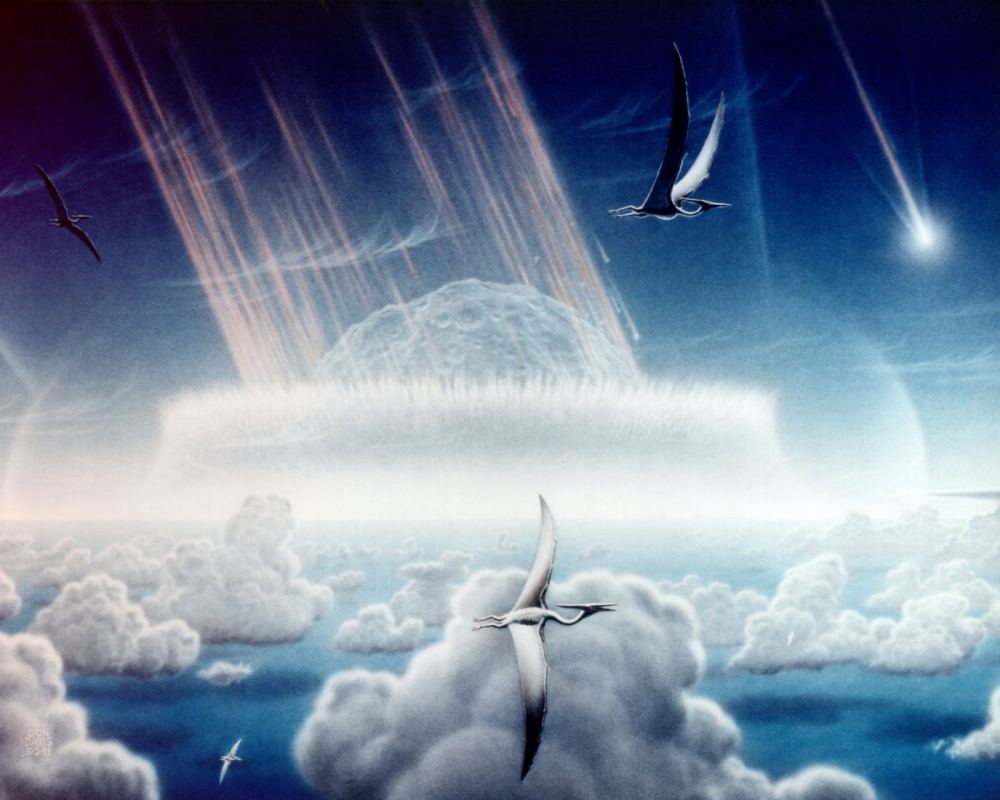
For decades, scientists have theorized that a massive impact caused the Cretaceous-Paleogene extinction event. This event occurred about 66 million years ago and caused the mass extinction of about 75% of all plant and animal species on Earth (including the non-avian dinosaurs). With the discovery of the massive Chicxulub crater in the Yucatan Peninsula (southern Mexico) in the 1970s, scientists concluded that they’d found the impact responsible. Based on all the available data, the Chicxulub Impact event is believed to have been as powerful as 100,000 billion metric tons (110,231 U.S tons) of TNT.
This blast was more powerful than all the nuclear devices in the world combined and sent an estimated 25 trillion metric tons (~27.5 US tons) of hot dust, ash, and steam into the atmosphere, creating a global winter. But according to new research led by the University of Michigan, an international team of geologists has determined that the impact also created a global tsunami. According to their findings, this tsunami was 30,000 times more powerful than the 2004 Indian Ocean tsunami, one of the largest and most devastating tsunamis on record.
Continue reading “The Asteroid That Killed the Dinosaurs Also Flooded the World's Coastlines With a Catastrophic Tsunami”What Was The Impact That Killed The Dinosaurs?
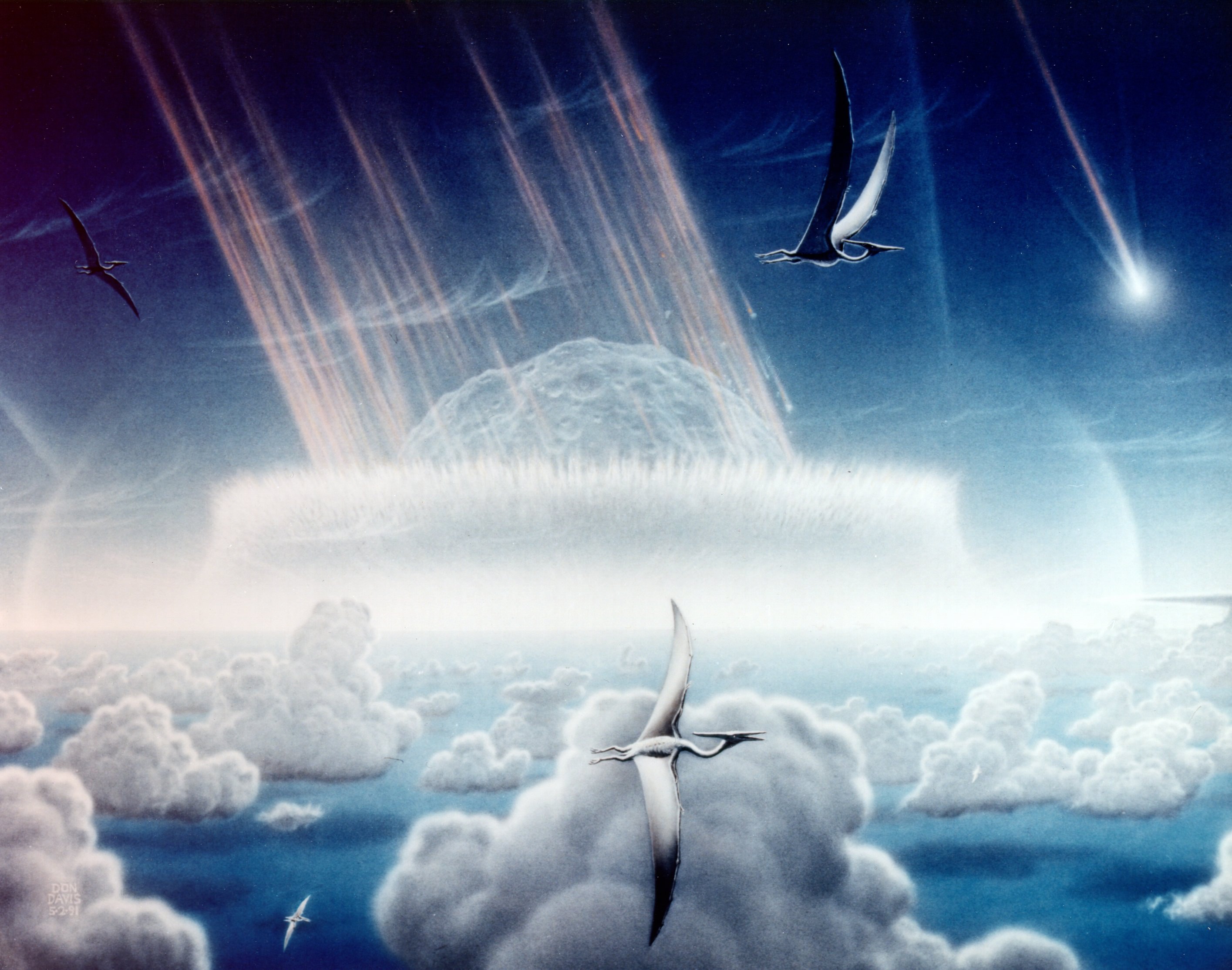
What suddenly made the dinosaurs disappear 65 million or 66 million years ago? Whatever it was, all indications show that it was a massive extinction event. The fossil record not only shows dinosaurs disappearing, but also numerous other species of the era. Whatever it was, there was a sudden change in the environment that changed evolution forever.
The leading theory for this change is a small body (likely an asteroid or a comet) that slammed into Mexico’s Yucatan Peninsula. The impact’s force generated enough debris to block the Sun worldwide, killing any survivors of starvation.
The crater
There have been numerous theories proposed for the dinosaurs’ death, but in 1980 more evidence arose for a huge impact on the Earth. This happened when a father-son University of California, Berkeley research team — Luis Alvarez and Walter Alvarez — discovered a link with a 110-mile (177-kilometer) wide impact crater near the Yucatan coast of Mexico. It’s now known as Chicxulub.
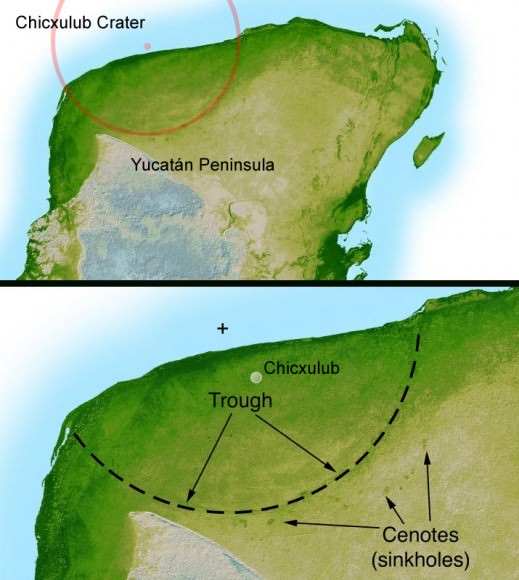
It sounds surprising that such a huge crater wasn’t found until that late, especially given satellites had been doing Earth observation for the better part of 20 years at that point. But as NASA explains, “Chicxulub … eluded detection for decades because it was hidden (and at the same time preserved) beneath a kilometer of younger rocks and sediments.”
The data came from a Mexican company that was seeking oil in the region. The geologists saw the structure and guessed, from its circular shape, that it was an impact crater. Further observations were done using magnetic and gravity data, NASA said, as well as space observations (including at least one shuttle mission).
The layer
The asteroid’s impact on Earth was quite catastrophic. Estimated at six miles (9.7 kilometers) wide, it carved out a substantial amount of debris that spread quickly around the Earth, aided by winds in the atmosphere.
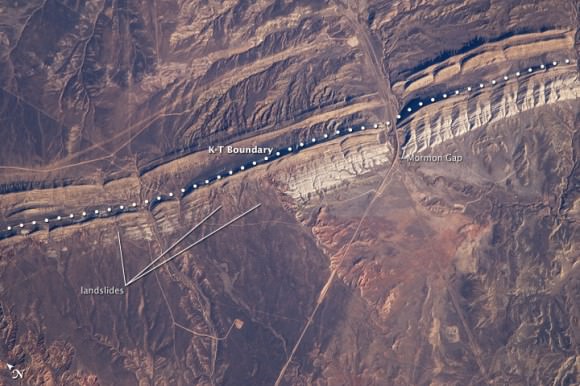
If you look in the fossil record all over the world, you will see a layer that is known as the “K-T Boundary”, referring to the boundary between the Cretaceous and Tertiary periods in geologic history. This layer, says the University of California, Berkeley, is made up of “glassy spheres or tektites, shocked quartz and a layer of iridium-enriched dust.”
Of note, iridium is a rare element on the surface of the Earth, but it’s fairly common in meteorites. (Some argue that the iridium could have come from volcanic eruptions churning it up from inside the Earth; for more information, see this Universe Today story.)
Was it simply ‘the last straw’?
While an asteroid (or comet) striking the Earth could certainly cause all the catastrophic events listed above, some scientists believe the dinosaurs were already on their last legs (so to speak) before the impact took place. Berkeley points to “dramatic climate variation” in the million years preceding the event, such as very cold periods in the tropical environment that the dinosaurs were used to.
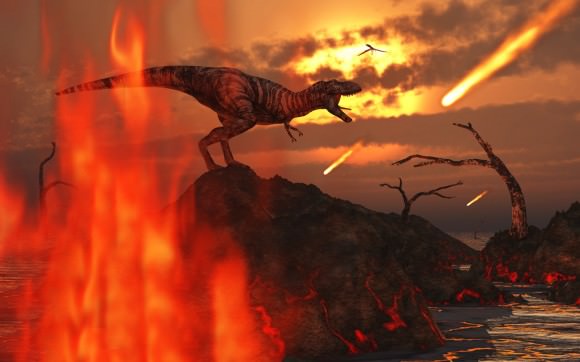
What might have caused this were several volcanic eruptions in India around the same time. Some scientists believe it was the volcanic eruptions themselves that caused the extinction and that the impact was not principally to blame, since the eruptions could also have produced the iridium layer. But Berkeley’s Paul Renne said the eruptions were more a catalyst for weakening the dinosaurs.
“These precursory phenomena made the global ecosystem much more sensitive to even relatively small triggers, so that what otherwise might have been a fairly minor effect shifted the ecosystem into a new state,” Renne stated in 2013. “The impact was the coup de grace.”
Here on Universe Today there are several articles on the asteroids and the Chicxulub Crater. Astronomy Cast has an episode on asteroids as bad neighbors.
Asteroid That Dwarfed Dinosaur-Killer Punched Earth 3 Billion Years Ago, Study Says
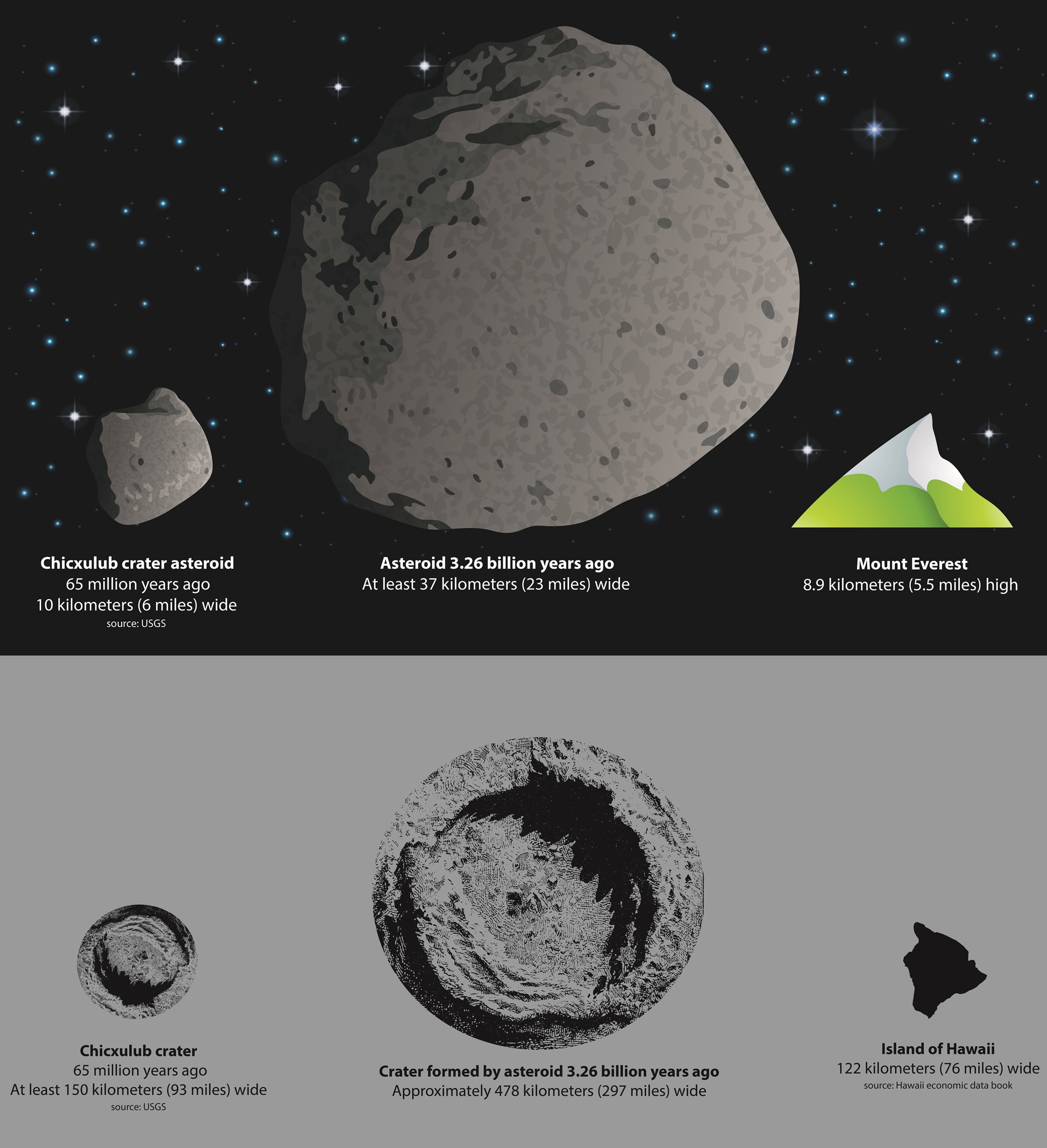
Early in Earth’s history, a killer asteroid smashed a hole in our planet about 300 miles (500 kilometers) wide, which is greater than the driving distance between Washington and New York City, a new study says. The space rock set off a cycle of destruction that sounds like your worst nightmares.
That one reported collision 3.26 billion years ago made the Earth tremble, created earthquakes and set off tsunamis that were thousands of meters deep, according to a new research team. The size of this estimated destructor? About 37 kilometers (23 miles) wide, or about three times as wide as the asteroid that killed the dinosaurs 65 million years ago.
“We knew it was big, but we didn’t know how big,” stated co-author Donald Lowe, a geologist at Stanford University and a co-author of the study, of the asteroid.
Evidence of the huge impact — the first one mapped from so long ago — comes from an examination of the Barberton Greenstone Belt in South Africa, which shows rocks and “crustal fractures” that are consistent with the idea of a giant impact, the scientists said. (The asteroid struck the Earth thousands of miles away, but where isn’t known.)
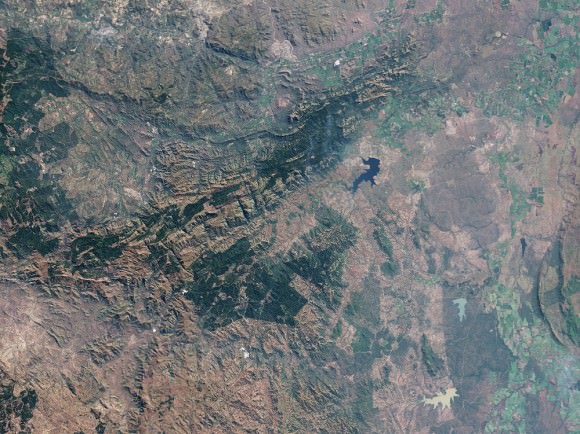
If confirmed, the asteroid could have been one of many that smacked Earth during what is known as the Late Heavy Bombardment period, which pummeled the solar system with debris between 3 billion and 4 billion years ago.
This one event could even have changed the way the Earth formed, the scientists added. For example, it could have been broken up our planet’s crust and tectonics, creating the plate tectonics we are familiar with today.
You can read more about the research in the journal Geochemistry, Geophysics, Geosystems. It was led by Norman Sleep, a geophysicist at Stanford University.
Source: American Geophysical Union


